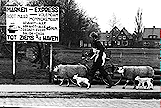Sheep
Information for the Apparel Industry and Textile Industry| Wool | Wool / Sheep Research |
Support the USA farmers & ranchers (American Sheep Industry Association).
 Yes, this man is walking his sheep.
Yes, this man is walking his sheep.
Breeds of Sheep (USA)
Wool Grades & Standard Measurements
You may also want to learn about lanolin, wool classing, wool insulations & wool baling.
Listed below you will find some of the various sheep breeds that currently reside in Australia.
The Merino
The Superfine Merino
The Superfine (Saxon) Merino is best suited to cool to warm conditions with 500mm or more of rainfall. It is found in the highlands of Tasmania, the cooler areas of Victoria and the tablelands of New South Wales. It is used solely for wool in the finest fabrics.
Advantages
- Superfine, soft wool
- Reasonably hardy, although not as hardy as the medium and strong types
Disadvantages
- Not suited to areas of high dust or burr levels as these get caught in the coat and have to be removed
- High incidence of fly strike as there is an opening in the fleece on the back
The Medium Merino
The Medium (Peppin) Merino is suited to the harsher conditions of inland Australia. It is mainly used for wool in jumpers and expensive carpets, although excess stock may be sold as mutton or the ewes cross-bred for prime lambs.
Advantages
- No wool opening in the back
- More resistant to extremes of temperature
- Hardy and adaptable
- Burrs do not stick as well on this fleece
The Strong Merino
The Strong (South Australian) Merino is suited to semi-arid conditions of 250mm of rain or less and is found in South Australia, Western Australia, Queensland and New South Wales. It is kept for wool but also produces useful mutton.
Advantages
- Thrives in arid regions
- High natural grease protects the fleece
Disadvantages
- Fleece rot occurs if kept in higher rainfall areas
The Corriedale
This breed is suited to many climates - from the New Zealand cold to the Australian heat. It is a dual-purpose sheep, used for wool and meat, as well as cross-breeding for prime lambs. The wool may be used for clothes or carpets.
Advantages
- Hardy and adaptable - tolerates longer periods of wet weather than the merino
- Matures quickly, giving good mutton
- High chance of having twins, so a flock can easily increase in numbers
Disadvantages
- Long wool causes a problem with seeds and burrs in long grass
- Fleece rot and body strike in high rainfall areas
The Border Leicester
The Border Leicester is suited for warmer, drier conditions. It is a dual purpose sheep which matures quickly and can be cross-bred for prime lambs which fatten quickly. The wool is used for hosiery and knitting wool.
Advantages
- Highly adaptable
- It has little fleece on its long legs, so seeds and burrs do not cause much trouble
- Does well on natural pasture
Disadvantages
- Coarse wool
- Lambs are not as good as Down breeds - as pastures improve the Border Leicester may become less popular
The Romney Marsh
This breed is best suited to cool, wet areas. It is a dual purpose sheep used for carpet wool, mutton and lamb, and it can be crossed for prime lambs.
Advantages
- Resistant to footrot and internal parasites
- Good prime lamb mothers
Disadvantages
- Grass seeds and burrs are a problem as it has long wool and short legs
The Dorset Horn
The Dorset Horn is best suited to warm, dry conditions. It is mainly a meat sheep, bit its wool can be used for hosiery or felt. This breed can also be used as a prime lamb sire or mother.
Advantages
- Adaptable
- Matures and fattens very quickly
- Good mothers
- Meat is of high quality
- Extended breeding season
Know that you have learned about sheep, don't forget to learn more about the benefits of wool from our article on the Fashion Blog.